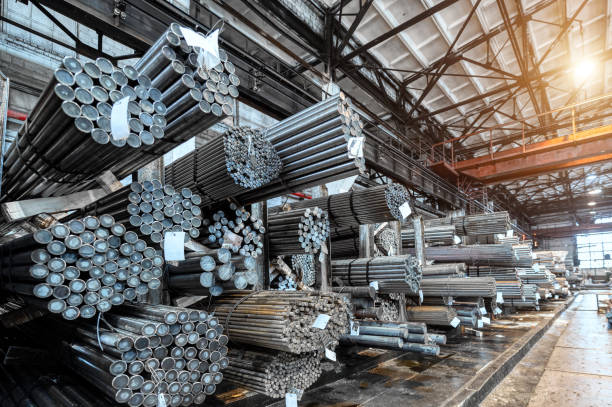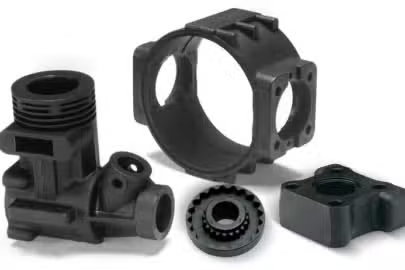Introduction
Stainless steel and steel are two of the most used metal alloys in manufacturing parts and components for various industries. Both metals are highly valuable to the manufacturing space because of their excellent properties, which include machinability, weldability, and formability, among other properties.
As the name of both alloys suggests, share some similarities between them. However, they are different, with clear distinctions. This article explores the similarities and differences between stainless steel vs steel.
Definition of Stainless Steel vs Steel
Steel is an alloy of iron and carbon, with other elements like manganese, nickel, vanadium, etc., existing in varying amounts. Likewise, stainless steel is also an alloy of iron and carbon, consisting of other similar alloying elements.
However, unlike regular steel alloys, stainless steel contains significant amounts of chromium, responsible for its corrosion resistance. Therefore the main distinction between stainless steel vs steel is the high amount of chromium in the former, which increases its protection against rusting and overall durability.
Stainless Steel vs Steel Composition Difference
Stainless steel and steel are alloys of iron, with similar composition. As mentioned earlier, the variation in either alloy is mostly related to the higher percentage of chromium in stainless steel, which significantly enhances its corrosion resistance.
Common Alloying Elements for Stainless Steel vs Steel
In the formation of steel, there are up to 20 different alloying elements, including chromium, that can enhance its mechanical properties.
Below are the most common alloying elements in the formation of these alloys.
- Manganese: The percentage of manganese in steel and stainless steel ranges from about 0.3 to 1.65% though mostly lower in stainless steel. Along with other elements like sulfur and phosphorus, it increases the malleability of steel alloys, making them less brittle.
- Chromium: The chromium content in standard steel is usually less than 0.5%, but ranges from about 10 to 30% in stainless steel. In small percentages, as in steel, it increases hardness, while in higher percentages, it significantly increases corrosion resistance.
- Nickel: Percentage of nickel in steel alloys, exists in varying amounts. When in about 5%, it results in increased strength. However, increasing the percentage, mostly in stainless steel, where it is often greater than 8 percent, increases its corrosion resistance.
- Vanadium: Usually about 0.15%, it increases the heat resistance and strength of steel without affecting its formability.
- Tungsten: Tungsten aids in increasing the structural integrity of the alloy, through increased heat and wear resistance. However, it’s more commonly used in steel than in stainless steel.
The Effects of Chromium on Stainless Steel
The addition of chromium (in larger amounts) is what transforms steel – an iron-based alloy – into a corrosion-resistant material. Generally, iron is susceptible to corrosion, upon exposure to suitable conditions of moisture and air.
However, the presence of chromium in stainless steel causes it to form a protective oxide layer – chromium oxide – upon reaction with oxygen against corrosion. This process is called stainless steel passivation, which is responsible for the self-repairing property of the alloy, making it more durable than other steel alloys.
While steel may contain chromium, it is usually in negligible amounts, not more than 0.5%. Therefore, it has little effect against corrosion; instead, it helps increase steel’s hardness.
Types of Steel Alloys
There are various classifications of steel alloys. Generally, steel alloy includes metals formed by the combo of iron and carbon with other alloying elements, as described above. Therefore, in the real sense, stainless steel itself is a type of steel alloy.
However, in this section, we will classify steel alloys into two, based on the percentage of other alloying elements, besides carbon and iron.
Low Alloy Steel
This class of steel alloy includes those with a low percentage of the alloying elements, usually not more than 5% of the total alloy composition. The addition of these elements increases the mechanical and chemical properties of the resulting steel, but less than the high alloy steel. Typical alloying elements include small amounts of nickel, vanadium, copper, tungsten, boron, copper, chromium, etc.
High Alloy Steel
High alloy steel contains a higher percentage of the alloying elements, that is more than 5%. Therefore, we can even classify stainless steel as high alloy steel, since it contains more than 12% chromium. The higher amounts of this class of steel often result in increased mechanical properties.

Types of Stainless Steel Alloys
Stainless steel exists in different variations, depending on the percentage of the alloying elements, especially chromium, which ensures distinctions in the alloy’s properties. Below, we will classify this alloy into five broad classes.
Ferritic Stainless Steel
This class of stainless steel contains 10.5% chromium, as its main alloying element, which ensures its significant corrosion resistance. This steel grade is magnetic and suitable for various automotive applications, including annealing conditions for increased strength. However, compared to some other stainless steel variants, it is less tough, which makes it more available as metal sheets and cool. Typical examples include SS 409 and 430.
Austenitic Stainless Steel
This grade of stainless steel contains about 17 to 25% chromium and 8 to 20% nickel, including other elements, further reducing its iron content. Therefore, it is non-magnetic but possesses excellent ductility, toughness, and corrosion resistance. Also, it has good weldability and formability, making it suitable for various applications such as in chemical processing and manufacturing of medical equipment, kitchen and household appliances. Typical examples include SS 316/316L, 304/304L and 253.
Martensitic Stainless Steel
Martensitic stainless steel contains between 12 to 16% chromium and carbon levels of not more than 2 percent. However, it is known for its considerable strength, hardness, and wear resistance. Also, it responds well to heat treatment but has reduced ductility and weldability. Its applications include manufacturing kitchen wares, like cutlery, bearings, and valve components. Examples of this stainless steel grade include 410, 431, and 420C SS.
Precipitation-hardening Stainless Steel
Like the martensitic grade, the precipitation-hardening stainless steel contains between 12 and 16% chromium, but more alloying elements. It contains about 3 to 9% nickel and other elements like aluminum, titanium, and copper in minute amounts, which forms the precipitate. The alloy achieves considerable strength through heat treatment. Also, it is strong, ductile, and resistant to corrosion. Because of these features, its main use includes use in aerospace and high-stress applications.
Duplex Stainless Steel
Duplex stainless steel grades are more or less a mixture of austenite and ferrite variants, making it share the features of both SS. The alloy contains about 18 to 29%chromium, and 3 to 8% nickel, including other elements like nitrogen and molybdenum. The resulting alloy possesses excellent corrosion resistance and strength and resistance to chloride stress and pitting. However, it is not heat-treatable and not suitable for cold working. Regardless, it is magnetic and has good weldability and formability, making it used for various engineering purposes. Typical examples include S32750 and 2205 SS grades.
Similarities Between Stainless Steel and Steel
Here, we will discuss the similarities between stainless steel and steel alloys under the following headings.
Iron-based alloys
We already indicated that both materials are iron-based alloys, with varying compositions of other elements. Regardless of the number of constituting elements in either alloy material, iron remains the primary constituent, forming the base and forming one of the reasons they share similar properties.
Versatility
Steel and stainless steel are two of the most used metals for manufacturing purposes because of their high versatility. Even with their varying mechanical properties, both materials are useful in various industrial applications, including parts fabrication, machinery, construction, aerospace, and automotive.
Machinability, Formability, and Weldability
Indeed, depending on the percentage of the alloying elements in the specific steel or stainless steel grade, they exhibit varying mechanical properties. However, both alloys have good machining, forming, and welding properties, which are what make them vital to the manufacturing space.
Recyclability
Both metal alloys are recyclable, making them, a good choice for reducing energy consumption, and promoting sustainability and conservation. Upon heating to the molten form, the metals can be remolded and reused to make new parts without losing their mechanical properties.
Heat Treatments
Besides having excellent mechanical properties, both metal alloys are heat treatable, to increase their hardness and ductility. Typical heat treatment for this purpose includes annealing, quenching, tampering, and stress relieving.
Comparing the Advantages of Stainless Steel and Steel
Since we have discussed the similarities between these two metal alloys, let’s proceed to discuss their differences. However, let’s start with the advantages of each over the other.
Advantages of Stainless Steel Over Steel
Below are ways stainless steel is more beneficial than standard steel.
- It has higher corrosion resistance.
- It is more aesthetically appealing, making it more suitable for decorative purposes
- Though generally more expensive, it has a reduced maintenance cost.
- It is more ductile.

Advantages of Steel Over Stainless Steel
Below are ways in which steel is more advantageous than stainless steel.
- It is more cost-effective and, therefore, better when dealing with budget constraints.
- Steel has a superior strength-to-weight ratio
- It is more versatile, because of its superior machinability
- It exhibits better resistance to temperature, because of its higher iron content
- Steel is generally magnetic, making it suitable for applications that require magnetic properties.
- While both alloys are recyclable, steel has a higher recyclable rate
Varying the Mechanical Features of Stainless Steel vs Steel
In this section, we will explore some of the differences between stainless steel vs steel, based on the typical properties of metals and alloys.
Tensile Strength
The tensile strength of a material is a measure of the material’s ability to withstand stress before breaking. Stainless steel and steel exhibit high tensile strength. However, steel generally has higher strength, about 750 to 1800 MPa, with stainless steel strength ranging from 500 to 830 MPa. This suggests that steel has a broader use for structural applications, requiring considerable strength.
However, we must emphasize that the gross variation is because of the different grades of these alloys. Moreover, the upper tensile strength limits are achievable after subjecting the alloys to suitable heat treatments.
Impact Resistance
Generally, there’s a close relationship between strength and impact energy, such that steel alloys with higher strength generally show more resistance to impact and shock. Therefore, upon considerable impact, stainless steel is more likely to break than steel, because of its lesser strength, toughness, and hardness.
Hardness
Again, we are just reiterating what we earlier mentioned, steel shows marked hardness compared to stainless steel. However, reinforcing the natural hardness of this metal alloy involves subjecting them to suitable heat treatments.
Conductivity
Because of the iron content as the base material, both metals conduct electricity. However, compared to steel, stainless steel is a poor conductor – this is because of the inclusion of various alloying elements. Still, the lower conductive properties of this material make it suitable for parts that require some electrical resistance.
Fatigue Resistance
Fatigue resistance is the ability of a material to resist stress over a certain number of cycles. The maximum stress the material can resist refers to its fatigue stress. Therefore, it is relatable to tensile strength, and shares the same variation for both alloys – steel has a higher fatigue resistance than stainless steel. However, some stainless steel like the duplex SS have incredibly high fatigue strength because of their microstructure.
Ductility and Malleability
Ductility refers to the property of a material to elongate, such as being drawn into wire, without breaking or fracturing. This feature can be enhanced through heat treatment. On the other hand, malleability refers to the ability of a material to the reshaping of a material, such as being beaten into sheets, without breaking.
Because of steel’s higher resistance to stress, impact, and fatigue, it generally has a higher ductility and malleability than stainless steel. However, both alloys have good formability, ductility, and malleability, making them useful for high-precision manufacturing, including the fabrication of parts with intricate details.
Difference in the Fabrication Properties of Stainless Steel vs Steel
We have already varied the general properties of these iron-based alloys. This section will focus on the difference in their properties as it relates to parts’ fabrication.
Machinability
Machinability refers to the ability to machine, cut, or size-reduce a material. While steel is tougher, it generally has better machining properties than steel. Steel has a better microstructure, which masks for more efficient tool cutting, producing cleaner and more manageable chips during CNC machining. Moreover, stainless steel is more likely to cause tool wear and tear.
Formability
Formability is the ability to reshape, deform, or restructure a material without any damage. Again, steel has better formality than stainless steel. You see, steel generally has better mechanical features than stainless steel, which also makes it a better choice for part fabrication.
Weldability
Regarding weldability, both alloys have good properties, though stainless steel is more weldable. The lower amounts of carbon, including the extra chromium content help create a more stable oxide increasing stainless steel’s weldability. However, it is still vital that you employ proper welding techniques to ensure success. Moreover, some stainless steel grades like martensitic and duplex stainless steel have low weldability.
Sheet Metal Fabrication
Both metal alloys have good sheet metal fabrication potentials and are often used for this purpose. However, because of steel’s better formability and malleability, it is a better choice for this purpose. However, it still depends on some manufacturing methods, as sheet metal fabrication may include machining, welding, and forming, among others.
Heat Treatments
There are different heat treatments for improving the mechanical properties of steel and stainless steel. Typical examples include the following:
- Annealing – Improves ductility
- Hardening and Quenching – increases strength and hardness
- Tempering – relieves brittleness and stress in a material
- Normalizing – relieving internal stress in a material
Generally, steel is more responsive to heat treatments than stainless steel, especially the higher carbon steel. Some stainless steel variants, such as martensitic steel, are highly responsive to heat treatments.
Varying the Applications of Stainless Steel vs Steel
Below is a table varying the applications of stainless steel vs steel. However, we must emphasize that both alloys share similar applications.
| Applications of Stainless Steel | Applications of Steel |
| Manufacturing kitchen equipment | Manufacturing structural components, like beams, and columns. |
| Aerospace components | Automotive components |
| Medical equipment | Machinery and heavy-duty equipment |
| Manufacturing chemical processing equipment | For construction purposes, such as building bridges and pipelines |
| Kitchen wares and household items | Shipbuilding |
| Marine equipment | Railroad tracks |
| Architectural components | Electronic and electrical equipment |

Factors to Determine Which Iron-based Alloys Suits Your Projects
Steel and stainless steel are highly versatile and suitable for different industrial applications. Below are criteria to consider when deciding on which best suits your manufacturing project.
Functional Requirements
The functional requirements of the fabrication play a crucial role in the kind of steel alloy that will suit your project. For example, if the major requirement is strength, such as in construction works, steel is the better choice. However, if the part will be used in harsh environments such as where there’s exposure to moisture or chemicals, then stainless steel is the better choice.
Aesthetics
Regarding aesthetics, stainless steel is the better choice. It is commonly used in interior design and for decorative purposes because of its sleek appearance and reflective properties. Moreover, since stainless steel is less likely to corrode; instead it continues to shine with a more refined appearance, it’s a more appropriate choice for aesthetic purposes.
Budget
Financial constraints may also determine your choice of steel alloy for your fabrication. If on a strict budget, then steel is the more reasonable choice. However, it is best that you do not because of costs to create what will not withstand its intended use, such as using steel to create parts where there is constant exposure to moisture.
Maintenance Costs
Indeed stainless steel is more expensive, but it’s the better option for maintenance reasons. Because it has better corrosion resistance, it requires less maintenance. Unlike steel parts which you’d often have to repaint to prevent corrosion or renew its appearance after rusting. Therefore, it is safe to say stainless steel is more durable than standard steel alloys.
Zintilon: Your Expert Partner for Steel and Stainless Steel Parts Fabrication
Understanding the differences between stainless steel vs steel is important for selecting the right material option for your fabrication. However, when fabricating parts, it is advised that you work with an expert in parts fabrication to ensure a successful project.
Zintilon offers premium services in various manufacturing processes requiring steel and other metal alloys, including plastics and composites. Our services include CNC machining, die casting, 3D printing, injection molding, and other related technologies.
Contact us today for all your manufacturing needs!
Conclusion
While regular individuals may assume that stainless steel and steel are the same thing, manufacturers and OEMs should never make that mistake. Even though materials are alloys of iron, they are different with varying mechanical and chemical properties. The main distinction is the higher corrosion resistance of stainless steel than steel. However, both alloys possess other good mechanical properties, like toughness, hardness, and strength, and support various manufacturing processes.
FAQs
How Can You Make Steel More Resistant to Corrosion?
You can improve the corrosion resistance of standard steel by applying protective coatings, such as galvanizing it or zinc coating. Routine maintenance practices such as painting with corrosion-resistant paints may also benefit against corrosion.
Is Stainless Steel Weldable?
Yes, stainless steel is weldable. In fact, stainless steel is more weldable than steel, though some grades possess less welding properties, affecting the part’s corrosion resistance. However, you still need to focus on utilizing proper welding techniques and post-welding treatments.
Great, Together


